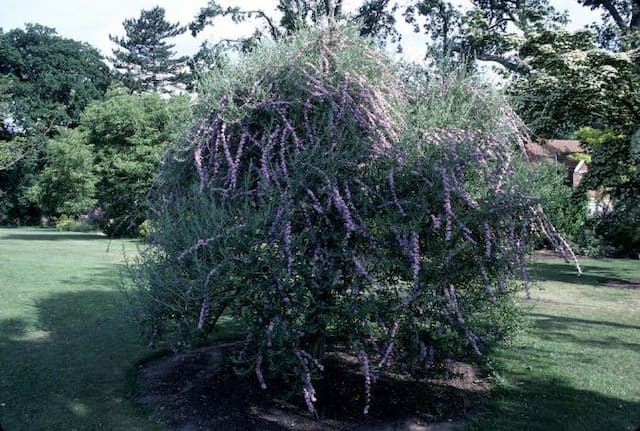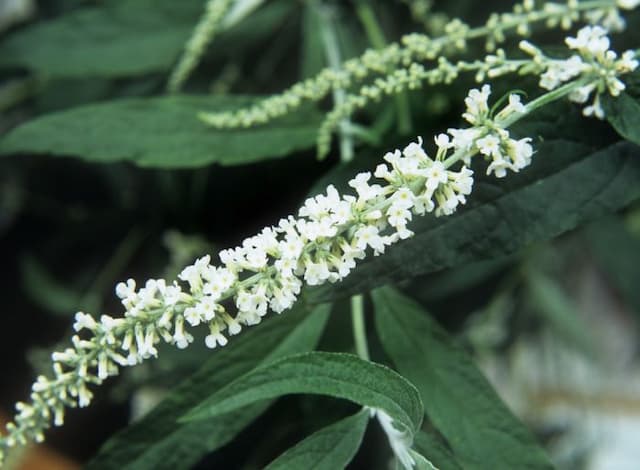Butterfly Bush Buddleja davidii 'Dartmoor'

ABOUT
The Buddleja davidii 'Dartmoor', commonly known as the Dartmoor Butterfly Bush, is a deciduous shrub that is highly regarded for its attractiveness to butterflies. This variety of butterfly bush boasts a dense growth habit with arching branches that bear lance-shaped, pointed leaves. The foliage usually has a soft, gray-green color, which is pleasantly muted and provides a lovely backdrop for the flowers. The Dartmoor Butterfly Bush is particularly celebrated for its striking flowers which appear in elongated clusters known as panicles. These flower clusters are typically quite large and can be a breathtaking feature of the shrub during bloom time. The individual flowers are small, tubular, and have a four-lobed corolla, giving them a delicate and intricate appearance. They are usually a deep purple or magenta color, although colors can vary slightly, and are sweetly scented, which contributes to their success in luring butterflies and other pollinators. One of the most distinctive characteristics of the Dartmoor Butterfly Bush’s flowers is the playful, almost tousled look of the blooms. The panicles are somewhat less densely packed with flowers compared to other butterfly bush varieties, which gives them a loose, open, and almost frothy appearance. This can add a sense of movement and wildness to the shrub, making it a favorite for creating a cottage garden aesthetic or for adding texture to a mixed border. In summary, the Dartmoor Butterfly Bush is a shrub with arching branches, soft gray-green leaves, and large, loosely-packed panicles of small, sweet-scented, tubular deep purple flowers, greatly loved by butterflies and admired for its unique, open appearance among flowering shrubs.
About this plant
 Names
NamesFamily
Scrophulariaceae
Synonyms
Summer Lilac, Butterfly Bush, Orange Eye
Common names
Buddleja variabilis 'Dartmoor'.
 Toxicity
ToxicityTo humans
Buddleja davidii, commonly known as butterfly bush, is not typically considered highly toxic to humans. However, some people may experience mild irritation or an allergic reaction if they come into contact with the plant's sap, or if they ingest parts of the plant. There is not much documented evidence of severe toxicity in humans due to ingestion of butterfly bush. As with any plant, it is prudent to exercise caution and keep it out of reach of small children who might accidentally ingest plant parts out of curiosity.
To pets
Butterfly bush is not commonly known to be toxic to pets either. Although it is not considered highly poisonous, it is generally recommended to prevent pets from ingesting plants. Some pets may have a sensitivity or allergic reaction to the plant, which could result in gastrointestinal upset such as vomiting or diarrhea. If you suspect your pet has ingested a large amount of butterfly bush or is showing symptoms of distress, it is best to consult with a veterinarian.
 Characteristics
CharacteristicsLife cycle
Perennials
Foliage type
Deciduous
Color of leaves
Green
Flower color
Purple
Height
10 feet [3 meters]
Spread
8 feet [2.4 meters]
Plant type
Shrub
Hardiness zones
5
Native area
China
Benefits
 General Benefits
General Benefits- Attracts Wildlife: The bright, fragrant flowers of the Butterfly Bush are magnets for butterflies, bees, and other beneficial insects.
- Easy to Grow: This plant is adaptable to a range of soil types and growing conditions, making it suitable for many gardeners.
- Drought Tolerant: Once established, the Butterfly Bush is relatively drought-resistant, requiring minimal watering in dry conditions.
- Fast Growth: Butterfly Bush can grow rapidly, providing quick results for gardeners looking to establish a mature garden.
- Long Blooming Period: The plant boasts a lengthy blooming season that extends from early summer to autumn, providing long-lasting color and interest.
- Low Maintenance: Requires minimal pruning and care once established, saving time and effort for gardeners.
- Ornamental Appeal: With its arching branches and conical clusters of flowers, the Butterfly Bush adds aesthetic value to any landscape design.
 Medical Properties
Medical Properties- This plant is not used for medical purposes.
 Air-purifying Qualities
Air-purifying QualitiesThis plant is not specifically known for air purifying qualities.
 Other Uses
Other Uses- Butterfly Attraction: Buddleja davidii 'Dartmoor', commonly known as Butterfly Bush, is often used to attract butterflies to the garden due to its fragrant and nectar-rich flowers.
- Potpourri Addition: Dried flowers of the Butterfly Bush can be included in potpourri mixes for their pleasant fragrance and color.
- Natural Dye: The flowers and leaves can be used to create natural dyes for textiles in shades of green and yellow.
- Photography Subject: Its striking blooms make the Butterfly Bush a popular plant for photographers looking to capture the beauty of gardens and pollinators.
- Privacy Screening: With its rapid growth and dense foliage, Butterfly Bush can be used to create quick natural privacy screens in gardens.
- Craft Projects: The woody stems can be dried and used in craft projects, such as homemade wreaths or for supporting other plants in arrangements.
- Erosion Control: Because of its robust rooting system, Butterfly Bush can be planted on slopes to help prevent soil erosion.
- Ornamental Focal Point: Its dramatic flower plumes make Butterfly Bush an excellent choice as a focal point in ornamental garden designs.
- Windbreaks: Dense plantings of Butterfly Bush can act as a windbreak, protecting more delicate plants from strong winds.
- Art Inspiration: The beauty and variety of colors in Butterfly Bush blooms offer inspiration to artists who may use it as a subject for paintings or illustrations.
Interesting Facts
 Feng Shui
Feng ShuiThe Butterfly Bush is not used in Feng Shui practice.
 Zodiac Sign Compitability
Zodiac Sign CompitabilityThe Butterfly Bush is not used in astrology practice.
 Plant Symbolism
Plant Symbolism- Renewal: Buddleja, also known as Butterfly Bush, often symbolizes renewal and new beginnings as it attracts butterflies which are themselves symbols of transformation and rebirth.
- Attraction: The plant's ability to attract a host of pollinators signifies the pulling of positive energies and influences into one's life.
- Hope: Its vigorous growth and resilience can represent hope, with the notion of overcoming obstacles and flourishing.
- Consolation: As a plant that provides nourishment to butterflies, it may also symbolize comfort and solace, offering a sanctuary to those in need.
- Encouragement: The vibrant and lively presence of butterflies around the bush can encourage joy and inspire a sunny disposition.
 Water
WaterThe Butterfly Bush (Buddleja davidii 'Dartmoor') should be watered regularly, particularly during its first growing season, to establish a deep, extensive root system. Once established, it is relatively drought tolerant and may require less frequent watering. Generally, applying about 1 inch of water once a week is enough, but this may vary depending on climate and soil conditions. During hot, dry periods, watering may need to be increased to twice a week. Always check the soil moisture at a depth of a few inches; it should be moist but not waterlogged. Overwatering can be detrimental and lead to root rot.
 Light
LightButterfly Bush thrives in full sun conditions, and it's best to plant it in a spot where it receives at least 6 to 8 hours of direct sunlight daily. The ideal location would be an unobstructed area away from tall trees or buildings that could cast shade. Adequate sunlight is crucial for optimal growth and flowering.
 Temperature
TemperatureButterfly Bush is hardy and can tolerate a wide range of temperatures, but it grows best in areas where the average temperature is between 60°F and 90°F. It can survive temperatures as low as 20°F but may die back to the ground in freezing conditions, resprouting in spring. The plant enjoys warm climates and shouldn't be exposed to prolonged periods below freezing.
 Pruning
PruningPruning the Butterfly Bush encourages new growth and more prolific flowering. Prune in late winter or early spring, cutting back the previous year's growth to about one foot high. This plant blooms on new wood, so annual pruning won't affect its ability to flower. Deadheading, or the removal of spent flowers, can also be done throughout the blooming season to maintain a tidy appearance and encourage additional blooms.
 Cleaning
CleaningAs needed
 Soil
SoilButterfly Bush prefers well-drained soil rich in organic matter with a pH between 6.0 and 7.0. A mix of two parts loam, one part peat moss or compost, and one part perlite or coarse sand is ideal, ensuring both fertility and good drainage.
 Repotting
RepottingButterfly Bushes are usually planted directly in the garden and do not require frequent repotting. In containers, young plants may need repotting every couple of years to promote growth.
 Humidity & Misting
Humidity & MistingThe Butterfly Bush is tolerant of a wide range of humidity levels and does not require specific humidity conditions for optimal growth; typical outdoor ambient humidity is sufficient.
 Suitable locations
Suitable locationsIndoor
Provide full sun, well-draining soil, and space.
Outdoor
Plant in full sun, well-drained soil, water regularly.
Hardiness zone
5-9 USDA
 Life cycle
Life cycleThe life of Buddleja davidii 'Dartmoor', commonly known as Butterfly Bush, begins with germination, which occurs when conditions are warm and moist, allowing the tiny seeds to sprout. Seedlings establish themselves quickly, developing a strong root system and foliage through the vegetative growth stage. As the plant matures, it enters the flowering stage in early to mid-summer, producing large panicles of fragrant flowers that attract butterflies and other pollinators; this stage can last until the first autumn frosts. After pollination, seeds form and are dispersed by wind, allowing the Butterfly Bush to propagate and start new plants in suitable nearby locations. During the cold season, Butterfly Bush enters a period of dormancy, with deciduous varieties shedding their leaves and enduring the winter before resuming growth in spring. This cycle repeats annually, with the plant potentially reaching large sizes if not pruned back.
 Propogation
PropogationPropogation time
Spring to Summer
The Butterfly Bush, specifically Buddleja davidii 'Dartmoor', is commonly propagated through semi-hardwood cuttings. This method involves taking a cutting from a mature plant during the summer months when the current season's growth has begun to harden but is not yet fully mature. These cuttings should be about 4 to 6 inches in length, with the leaves removed from the lower half to reduce moisture loss and prevent rotting when planted. The cut base of the cutting is often dipped in rooting hormone to encourage root growth and then placed in a well-draining soil mix or propagation medium. The cuttings should be kept under conditions of high humidity and consistent warmth, typically using a misting system or a plastic cover to maintain the environment. Roots usually develop within a few weeks to a couple of months, after which the new plants can be gradually acclimatized to less humid conditions before being transplanted to their final location.



![Butterfly bush [Florence]](/_next/image?url=https%3A%2F%2Fplants-admin.emdemapps.com%2Fimages%2Fplants%2F%2Fimages%2F604b5f52d7bb1.png&w=640&q=75)
![Butterfly bush [Nanho Blue]](/_next/image?url=https%3A%2F%2Fplants-admin.emdemapps.com%2Fimages%2Fplants%2F%2Fimages%2F604b55d0a6d2d.png&w=640&q=75)




